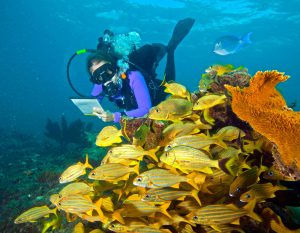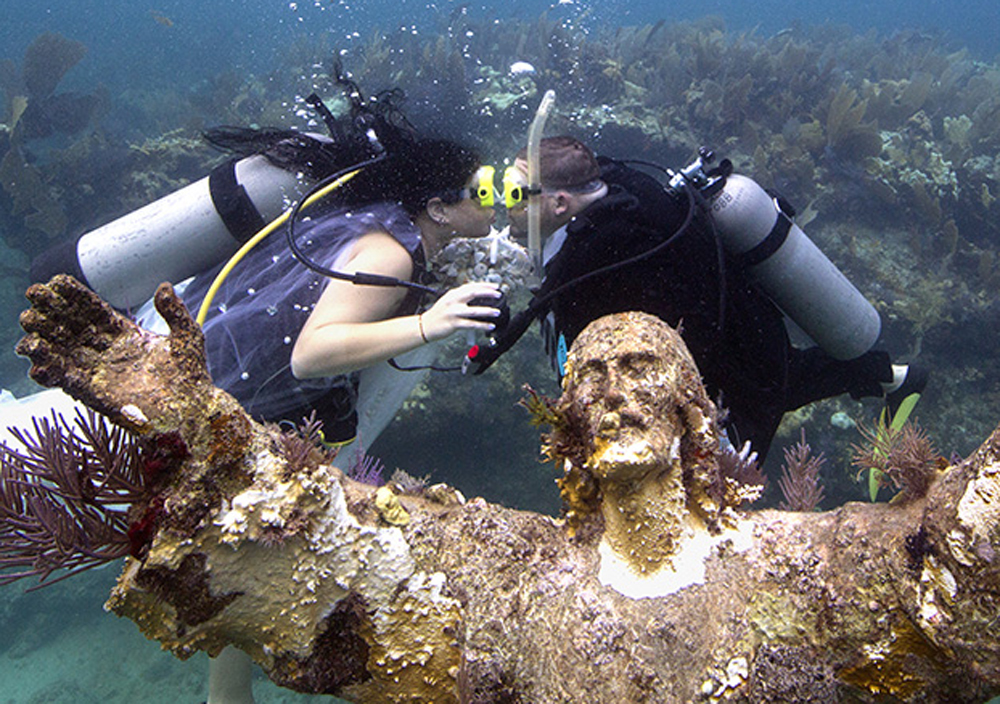There are a million reasons to love the Florida Keys, but without the spectacular coral reefs that surround the magical place, those reasons wouldn’t exist at all. Known worldwide for unmatched beauty, with their coastal waters protected within the Florida Keys National Marine Sanctuary, the Keys offer underwater adventures that can’t be enjoyed anywhere except in the island chain.
For example, you can snorkel or dive on the continental United States’ only contiguous living coral barrier reef — also the third-largest barrier reef in the world — that’s home to an incredibly diverse population of plants and animals as well as stunning coral formations.
And if you’re in the mood to get married, the Florida Keys’ clear, warm waters also attract scuba aficionados ready to tie the knot at the reef, attended by curious tropical reef fish. The wedding party and guests can don gowns, tuxedos, boutonnières — and bathing suits! — for a uniquely marine matrimony.
Probably the best-known Upper Keys underwater nuptial spot is the 9-foot-high shrine of “Christ of the Deep,” a 4,000-pound bronze statue within the marine sanctuary. Placed in waters adjacent to Key Largo’s John Pennekamp Coral Reef State Park, America’s first undersea park, the statue is one of the most photographed underwater sites in the world. Its welcoming arms make it a perfect place to exchange “I do’s.”
You can also explore an area of the iconic Keys reef while swaying to an annual sub-sea concert (yes, really!). It’s called the Lower Keys Underwater Music Festival and it’s traditionally staged on the first Saturday after the July 4 holiday. Music is broadcast underwater via speakers suspended beneath boats moored above Looe Key Reef, a gorgeous part of the marine sanctuary that lies approximately 6 miles south of Big Pine Key.

In the Florida Keys, recreational divers can connect with and help protect the ocean realm in many ways. Here, a diver is shown volunteering by participating in a fish count, collecting valuable information for environmental organizations. (Photo by Nathan Brown)
The festival’s fundamental message is reef preservation. The underwater broadcast features diver awareness announcements emphasizing ways you can enjoy the reef while minimizing impacts on the underwater environment.
If you’re interested in actively supporting that environment, take advantage of the Keys’ growing dive voluntourism opportunities. Certified divers can join hands-on activities in underwater coral nurseries — outplanting corals to Keys reefs and monitoring the wellness of corals in existing coral colonies, as well as participating in marine debris cleanup dives along the reef.
Multiple coral restoration organizations are engaged in an ongoing mission to preserve the Keys’ reefs, exploring the challenges reefs are facing, what research is being done, and how people can get involved. They include Key Largo’s Coral Restoration Foundation™, the Summerland Key–based Elizabeth Moore International Center for Coral Reef Research and Restoration (a field station for Mote Marine Laboratory), and Islamorada’s I.CARE.
Each organization invites divers and snorkelers to assist with the endeavor as “citizen scientists,” illustrating the significant role divers play as stewards of the world’s oceans. Through such opportunities, you can productively give back to the living, dynamic underwater ecosystem.

Thunderbolt, among the vessels on the Florida Keys Wreck Trek, was sunk as a dive attraction off Marathon in 1986. (Photo by Stephen Frink)
Two other unique programs spotlight Keys coral reefs and shipwrecks for enthusiasts, and each offers specially created souvenir journals for participants.
Advanced or wreck-certified divers who complete at least one wreck dive with a participating dive operator receive the Florida Keys Wreck Trek logbook that lists nine of the island chain’s most iconic wreck sites: Duane, Benwood, Eagle, Thunderbolt, Adolphus Busch Senior, Cayman Salvager, Joe’s Tug and two of the world’s largest shipwrecks intentionally sunk as artificial reefs — Spiegel Grove and Gen. Hoyt S. Vandenberg. Divers also can receive a personalized print of Florida Keys shipwrecks.
The Become a Reef Explorer program was designed for first-time divers and/or snorkelers, families and fun-loving adventure groups. Participants can collect validation stamps for their souvenir journal from professional dive or snorkel operators with whom they visit one (or all) of the coral reefs highlighted in the journal.
If you’re ready to dive into the one-of-a-kind underwater activities to be found in the Florida Keys, the next step is easy: just click here and begin your adventure.


